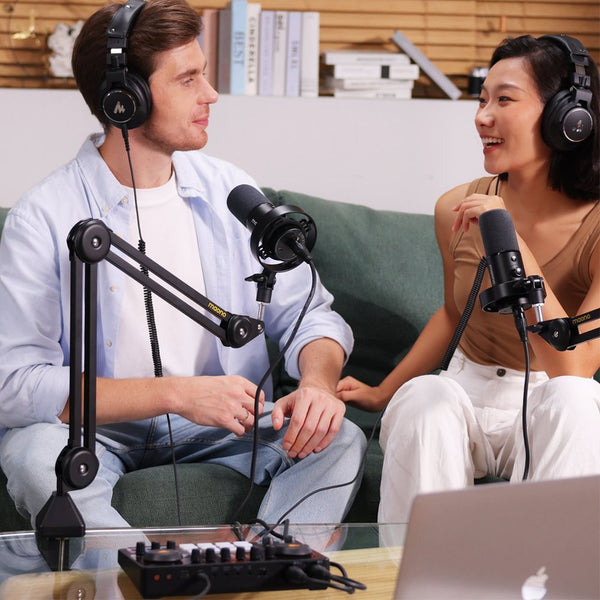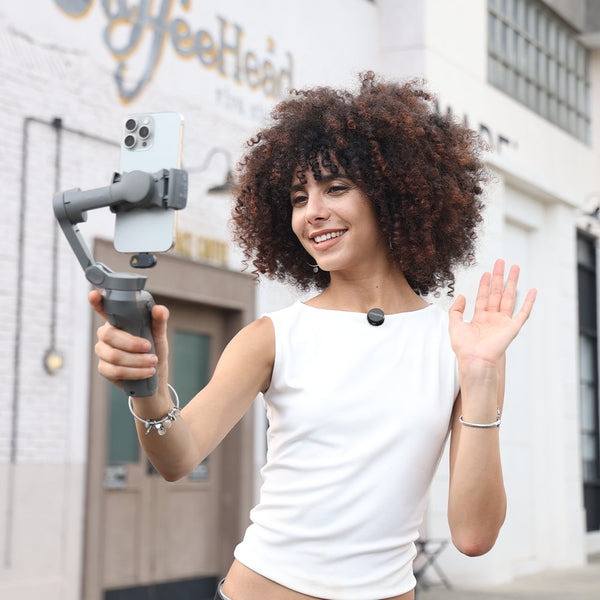Are you a doctor or healthcare specialist who wants to give medical advice through platforms like Facebook, YouTube, or TikTok? No worries. Using a streaming microphone allows you to be heard clearly by your audience, and your message will be delivered with clarity across social media platforms. If you're a professional doctor or licensed healthcare practitioner just starting out with streaming, this article will address some of the questions you might have already asked when beginning your stream.
The rise of live streaming and short-form content has opened new opportunities for doctors to share medical knowledge with the public in real-time. From answering health-related questions to debunking common myths, physicians are increasingly turning to platforms like YouTube, Instagram, and Facebook to connect with a wider audience. A common question among medical professionals entering the space is: Can I use a USB microphone for professional medical content?
The short answer: absolutely. A high-quality USB microphone can deliver broadcast-level audio without the technical complexity of XLR setups. When presenting health information online, clarity and trust are everything, and great audio plays a crucial role in achieving both. In this article, we’ll walk through how to set up your studio, navigate professional ethics, boost engagement, and choose the right gear—especially your streaming microphone.

How to Set Up Your Home Studio for Medical Live Streams
Creating a credible and clean live streaming setup doesn’t require a television studio. Here’s what you need:
-
USB Microphone
Choose a microphone USB PC setup that minimizes ambient noise and delivers crisp vocal clarity. A cardioid condenser USB mic is ideal for this. Many doctors and health professionals find that a best budget USB microphone like the Maono PM450 offers excellent quality without the high price tag, perfect for educational live streams.
-
Lighting
Use softbox lights or ring lights to create a clean, professional appearance on camera.
-
Camera
A 1080p webcam or DSLR connected via capture card is sufficient.
-
Background
Opt for a clean, neutral background or a branded setting (bookshelves, medical degrees, or your clinic wall work well).
-
Streaming Software
Tools like OBS Studio or StreamYard help you manage visuals, overlays, and audio in real time. These pair seamlessly with your streamer microphone setup to ensure everything from voice to visuals appears polished and professional.
Remember, your streamer microphone is the heart of your setup—clear audio makes your insights easy to follow and more trustworthy to listeners.
Remember, your microphone is the heart of your setup—clear audio makes your insights easy to follow and more trustworthy to listeners.
About Content and Medical Professional Practice
How do I handle incorrect health advice in the comments during a live?
Misinformation can spread fast, especially in live chats. Remain professional and calm. Kindly correct the misinformation, and, if necessary, refer viewers to credible sources like CDC, WHO, or peer-reviewed journals.
What are good topics for doctors to stream about each week?
-
Myth-busting common health fads
-
Seasonal illness updates (flu, allergies, etc.)
-
Mental health check-ins
-
“Ask Me Anything” health Q&As
-
Behind-the-scenes at your clinic (HIPAA-compliant)
-
Discussions on nutrition, fitness, and chronic disease management
Should I interact with viewers live or pre-record content for better accuracy?
Both have value. Pre-recorded videos offer more control and editing, which helps avoid errors. Live streams, on the other hand, foster real-time connection. For complex topics, consider pre-recording. For general advice, Q&As, or awareness campaigns, live interactions build stronger relationships—especially when supported by a reliable streamer microphone setup.
How can I get more engagement on my health-related live streams?
-
Use attention-grabbing headlines
-
Start with a hook or a common myth
-
Ask viewers to comment or ask questions
-
Use polls or quizzes to engage midstream
-
Respond by name when answering viewer questions
How do I convert live viewers into long-term patients or followers?
End streams with a clear call-to-action (CTA):
-
“Follow me for weekly health tips.”
-
“Visit my website to book a telehealth appointment.”
-
“Join my email list for exclusive health updates.”
Use your social handles and links consistently in overlays and captions.
How can I ensure I'm following HIPAA or patient privacy laws while streaming?
Avoid discussing or showing any patient-specific information. Don’t reference names, conditions, or timelines unless it's hypothetical or publicly disclosed with consent. Stick to general advice, and use phrases like, “This information is for educational purposes only.”
What disclaimers should I include when giving health information online?
Always have a visible or spoken disclaimer:
“This content is not medical advice and is for educational purposes only. Please consult your physician for individual health concerns.”
Add it to your video description, intro slide, or even as part of your lower third graphic.
How can I build trust with viewers when offering health tips on social media?
-
Wear your white coat or scrubs for recognition
-
Share your credentials early in the stream
-
Reference peer-reviewed sources or guidelines
-
Be transparent about your limitations—e.g., “This doesn’t replace a clinical visit.”
-
Speak plainly without using excessive jargon
What kind of content should doctors avoid during live streams?
-
Diagnosing individuals live
-
Discussing patient stories without consent
-
Promoting unproven treatments
-
Using fear-based messaging
-
Making health claims not backed by evidence
On Streaming & Setup:
What platform is best for live-streaming medical content—YouTube, Instagram, or Facebook?
-
YouTube: Great for long-form educational content; monetization options available
-
Instagram: Ideal for short, engaging health tips and mobile audiences
-
Facebook: Best for community-building and attracting older demographics
Use a multistreaming tool (like Restream or StreamYard) to reach audiences across multiple platforms simultaneously and make the most of your streamer microphone and camera setup.
Do I need a mixer or audio interface to improve sound quality for medical webinars?
With a microphone USB PC setup, you don’t need an external mixer or audio interface. USB mics plug directly into your computer and often include built-in gain control, mute buttons, and zero-latency monitoring. However, if you decide to upgrade to an XLR mic, then an audio interface becomes necessary.
What software works best with streaming mics for doctors doing live sessions?
-
OBS Studio (free): Powerful, customizable for PC and Mac
-
StreamYard: Browser-based, easy interface for interviews and overlays
-
Ecamm Live (Mac only): Feature-rich with a polished interface
-
Zoom: Works well for webinars and professional calls, but less engaging for public streaming
FAQs About a Streaming Microphone for Doctors:
What is the best microphone for doctors doing live medical Q&As?
A great recommendation is the Maono PM450 USB Condenser Microphone. It stands out as one of the best streamer microphone options for professionals on a budget.
Notable Specs of the Maono PM450:
-
Microphone Type: Condenser
-
Polar Pattern: Cardioid (perfect for rejecting background noise)
-
Frequency Response: 20Hz–20kHz
-
Bit Depth/Sample Rate: 24-bit/192kHz for studio-quality audio
-
Connectivity: Plug-and-play USB
-
Features: Onboard gain control, mute button, metal construction, included boom arm
This mic helps medical professionals achieve studio-like audio with zero technical hassle—ideal for solo streaming, online Q&As, and health webinars. It’s also a top choice among the best budget USB microphone options currently available.
How do I reduce background noise while giving medical advice online?
-
Use a cardioid microphone that focuses on sound from the front (like the Maono PM450)
-
Stream in a quiet, carpeted room with soft furnishings
-
Avoid typing or rustling papers near the mic
-
Add a foam windscreen or pop filter
-
Use noise suppression filters in your streaming software (OBS offers this built-in)
Conclusion
Streaming medical advice has the power to educate, inspire, and connect physicians with a broader audience. Whether you’re discussing flu season, sharing mental health tips, or busting health myths, your credibility starts with clear, confident communication. That begins with quality audio.
A streamer microphone like the Maono PM450 allows doctors to sound professional without a steep learning curve or studio investment. Combined with a thoughtful content plan, ethical considerations, and platform strategy, you can transform your live streams into trusted health resources that build lasting relationships with viewers.
Remember: good audio equals clarity. Clarity builds trust. And trust makes you not just a streamer—but a reliable voice in the digital health space.



